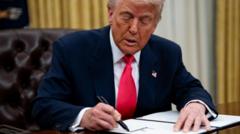However, experts warn that the executive order will likely face significant legal hurdles. The dismantling of a federal department is not solely within presidential purview and would require congressional approval to be fully realized. This vagueness has left room for interpretation and criticism, especially amid warnings from legal experts about the implications for federal education programs, student loans, and services designed to support low-income students.
With federal educational funding constituting only 13% of total K-12 education financing in the U.S., the majority originates from state and local sources. This points to a common misconception about the federal education department's role, further complicating the debate about its reliability and necessity. Critics of the administration argue that failing to clearly define the manner in which the Department's programs would be discontinued poses risks for millions of students.
Trump's executive mandate has garnered mixed reactions, especially from teachers' unions and educational advocacy groups, which argue that the move would disproportionally affect students with disabilities and those from impoverished backgrounds. The American Federation of Teachers condemned the decision as a politically motivated act detrimental to educational equity.
Furthermore, the implementation of this order may also lead to sweeping job cuts within the department, where previous staff reductions due to government efficiency initiatives have already impacted approximately 2,100 employees. The fate of these workers and the future landscape of educational policy in the U.S. remain uncertain.
Ultimately, while Trump’s executive order serves to advance a long-held conservative goal, it raises significant questions about the future of education policy, the balance of power between state and federal governance, and the inherent challenges of executing an agenda that has historically faced strong opposition in Congress. As this story unfolds, the implications for American education, students, and educators remain critical points of concern going forward.
With federal educational funding constituting only 13% of total K-12 education financing in the U.S., the majority originates from state and local sources. This points to a common misconception about the federal education department's role, further complicating the debate about its reliability and necessity. Critics of the administration argue that failing to clearly define the manner in which the Department's programs would be discontinued poses risks for millions of students.
Trump's executive mandate has garnered mixed reactions, especially from teachers' unions and educational advocacy groups, which argue that the move would disproportionally affect students with disabilities and those from impoverished backgrounds. The American Federation of Teachers condemned the decision as a politically motivated act detrimental to educational equity.
Furthermore, the implementation of this order may also lead to sweeping job cuts within the department, where previous staff reductions due to government efficiency initiatives have already impacted approximately 2,100 employees. The fate of these workers and the future landscape of educational policy in the U.S. remain uncertain.
Ultimately, while Trump’s executive order serves to advance a long-held conservative goal, it raises significant questions about the future of education policy, the balance of power between state and federal governance, and the inherent challenges of executing an agenda that has historically faced strong opposition in Congress. As this story unfolds, the implications for American education, students, and educators remain critical points of concern going forward.





















